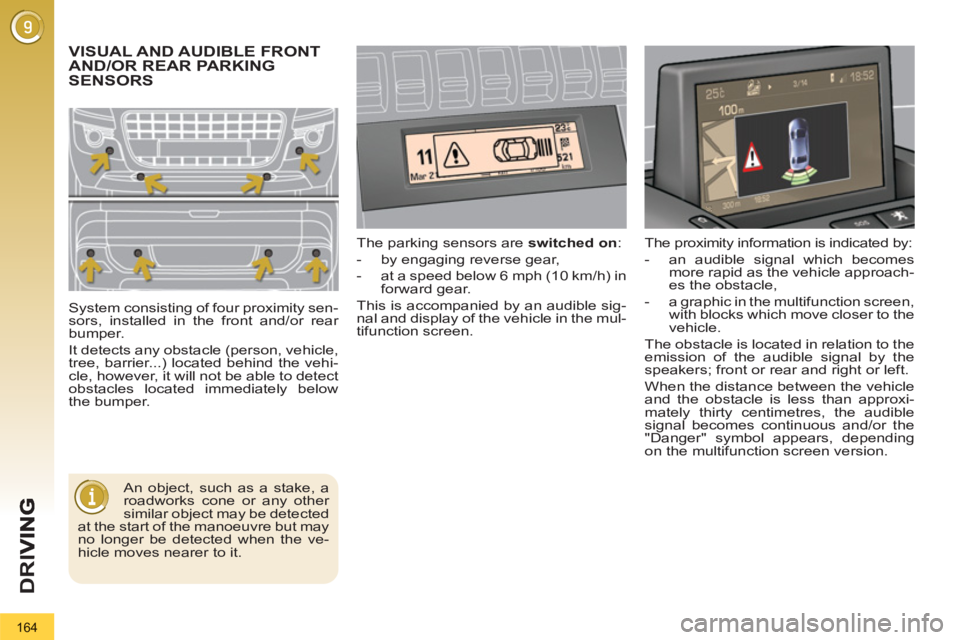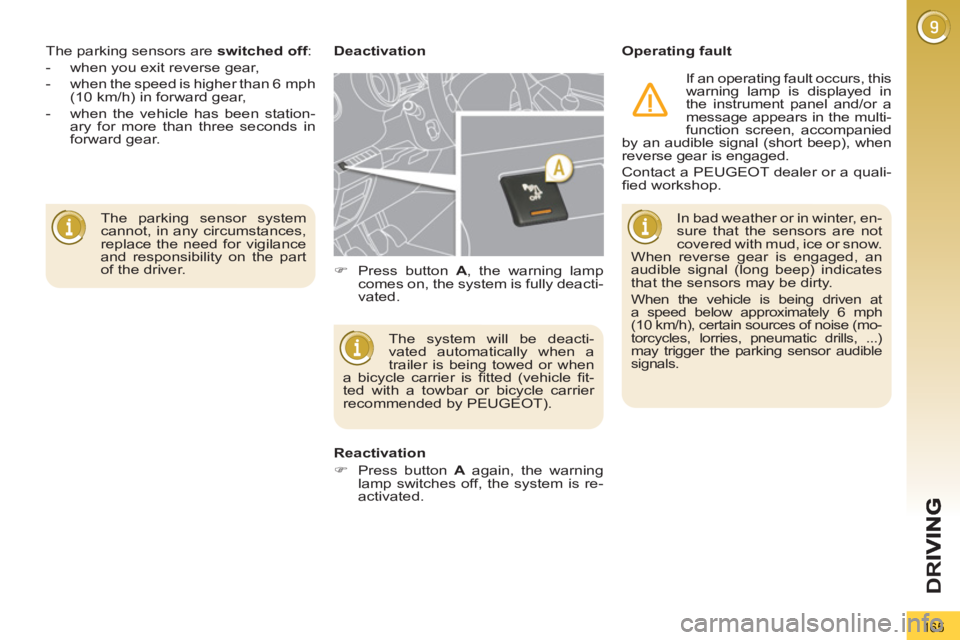Page 5 of 352

CONTENTS
ALPHABETICAL
INDEX 337-341
DRIVING 137-165
CHECKS 166-17
4
PRACTICAL
INFORMATION 175-206
TECHNICALDATA 207-214
AUDIO EQUIPMENT andTELEMATICS 215-336
Electric parking brake 137Hill start assist 142Head-up display 145Distance alert 147Speed limiter 149Cruise control 151Manual gearbox 153Gear shift indicator 1536-speed electronic gear control gearbox 154Automatic gearbox 158Stop & Start 161Parking sensors 164
Bonnet 167Running out of fuel (Diesel) 168Petrol engines 169Diesel engines 170Checking levels 171Checks 173
Temporary puncture repair kit 175Changing a wheel 181Changing a bulb 186Changing a fuse 19112 V battery 198Energy economy mode 201Changing a wiper blade 202
Towing the vehicle 202Towing a trailer 204Fitting roof bars 205Very cold climate screen 205Accessories 206
Petrol engines 207Petrol weights 208Diesel engines 209Diesel weights 210Dimensions 212
Identification markings 213
Emergency or assistance 215Peugeot Connect Media
Navigation (NG4 3D) 219Peugeot Connect Navigation (RT6)263Peugeot Connect Sound (RD5) 317
VISUAL
SEARCH 342-348
Page 7 of 352
5
EXTERIOR
Temporary puncture repair kit
This kit is a complete system, consisting
of a compressor and an integral sealant
cartridge, for the temporary repair of a
tyre.
175
Visual and audible front and/or rear
parking sensors
This system warns you if an obstacle is
detected behind or in front of the vehicle
in reverse or forward gear.
164
When using an automatic car wash:
- unscrew the aerial,
- fold back the mirrors.
Lower tailgate
This lower tailgate permits remarkable
accessibility and makes the loading of
bulky objects easier.
84
Page 11 of 352
9
INSTRUMENTS AND CONTROLS
1.
Cruise control / speed limiter
switches.
2.
Steering wheel adjustment control.
3.
Lighting and direction indicator
control stalk.
4.
Instrument panel.
5.
Driver's airbag.
Horn.
6.
Gear lever.
7.
Electric parking brake.
8.
Front armrest - Peugeot Connect
USB and/or auxiliary socket.
9.
Bonnet release.
10.
Driver's storage compartment
(Handbook).
11 .
Alarm button.
Parking sensors button.
Dynamic stability control button
(ESC/ASR).
Stop & Start deactivation button.
12.
Manual headlamp adjustment.
13.
Door mirror controls.
Electric window controls.
Child lock.
14.
Front side window demisting vent.
15.
Windscreen demisting vent.
Page 18 of 352
16
MONITORING
Instrument
panel
A.
With the ignition on, the needle should
indicate the level of fuel remaining.
B.
With the engine running, its associated
low level warning lamp should go off.
C.
With the ignition on, the oil level in-
dicator should display "OIL OK"
for
a few seconds.
If the levels are not correct, top up the
levels which are low.
27
1.
With the ignition on, the orange and
red warning lamps come on.
2.
With the engine running, these
warning lamps should go off.
If warning lamps remain on, refer to the
page concerned.
29
Switch panels
Lighting of the indicator lamp indicates
the status of the corresponding function.
A.
Visual and audible
parking sensors. 164
127
80, 123
162
77
145
124
147
B.
ESC/DSC OFF
(without Grip control).
C.
Child lock.
D.
Deactivating the
Stop & Start system.
E.
Volumetric alarm.
F.
Head-up display.
G.
Hazard warning lamps.
H.
Distance alert.
Lower
Central
I.
Central locking. 82
Page 166 of 352

164
D
R
I
VISUAL AND AUDIBLE FRONT
AND/OR REAR PARKING
SENSORS
System consisting of four proximity sen-
sors, installed in the front and/or rear
bumper.
It detects any obstacle (person, vehicle,
tree, barrier...) located behind the vehi-
cle, however, it will not be able to detect
obstacles located immediately below
the bumper. The parking sensors are switched on
:
- by engaging reverse gear,
- at a speed below 6 mph (10 km/h) in
forward gear.
This is accompanied by an audible sig-
nal and display of the vehicle in the mul-
tifunction screen.
An object, such as a stake, a
roadworks cone or any other
similar object may be detected
at the start of the manoeuvre but may
no longer be detected when the ve-
hicle moves nearer to it. The proximity information is indicated by:
- an audible signal which becomes
more rapid as the vehicle approach-
es the obstacle,
- a graphic in the multifunction screen,
with blocks which move closer to the
vehicle.
The obstacle is located in relation to the
emission of the audible signal by the
speakers; front or rear and right or left.
When the distance between the vehicle
and the obstacle is less than approxi-
mately thirty centimetres, the audible
signal becomes continuous and/or the
"Danger" symbol appears, depending
on the multifunction screen version.
Page 167 of 352

165
D
R
The parking sensor system
cannot, in any circumstances,
replace the need for vigilance
and responsibility on the part
of the driver. The parking sensors are switched off
:
- when you exit reverse gear,
- when the speed is higher than 6 mph
(10 km/h) in forward gear,
- when the vehicle has been station-
ary for more than three seconds in
forward gear.
Deactivation
Operating fault
The system will be deacti-
vated automatically when a
trailer is being towed or when
a bicycle carrier is fi tted (vehicle fi t-
ted with a towbar or bicycle carrier
recommended by PEUGEOT).
Reactivation
�)
Press button A
again, the warning
lamp switches off, the system is re-
activated.
�)
Press button A
, the warning lamp
comes on, the system is fully deacti-
vated. In bad weather or in winter, en-
sure that the sensors are not
covered with mud, ice or snow.
When reverse gear is engaged, an
audible signal (long beep) indicates
that the sensors may be dirty.
When the vehicle is being driven at
a speed below approximately 6 mph
(10 km/h), certain sources of noise (mo-
torcycles, lorries, pneumatic drills, ...)
may trigger the parking sensor audible
signals.
If an operating fault occurs, this
warning lamp is displayed in
the instrument panel and/or a
message appears in the multi-
function screen, accompanied
by an audible signal (short beep), when
reverse gear is engaged.
Contact a PEUGEOT dealer or a quali-
fi ed workshop.
Page 196 of 352
194
PRACTICAL INFORMATION
Fuse
N°
Rating
(A)
Functions
F29
-
Nor used.
F30
5
Heated door mirrors.
F31
30
Boot 12 V socket.
F32
5
Electronic gear control gearbox gear lever.
F33
10
Head-up display, Bluetooth system, air
conditioning.
F34
5
Seat belt warning lamp display.
F35
10
Parking sensors, Hi-Fi amplifi er authorisation.
F36
10
Trailer fusebox control unit, driver's door
control pad.
F37
20
Hi-Fi amplifi er.
F38
30
Driver's electric seat.
F39
20
Panoramic sunroof blind.
F40
-
Not used.
Page 206 of 352

204
PRACTICAL INFORMATION
TOWING A TRAILER
Your vehicle is primarily designed for
transporting people and luggage, but it
may also be used for towing a trailer.
Driving advice
The maximum towed load on a long in-
cline depends on the gradient and the
ambient temperature.
In all cases, keep a check on the cool-
ant temperature.
Side wind
�)
Take into account the increased
sensitivity to side wind.
Cooling
Towing a trailer on a slope increases
the temperature of the coolant.
As the fan is electrically controlled, its
cooling capacity is not dependent on
the engine speed.
�)
To lower the engine speed, reduce
your speed.
Braking
Towing a trailer increases the braking
distance.
To avoid overheating of the brakes on a
long mountain type of descent, the use
of engine braking is recommended.
Tyres
�)
Check the tyre pressures of the towing
vehicle and of the trailer, observing the
recommended pressures.
Lighting
�)
Check the electrical lighting and sig-
nalling on the trailer.
The rear parking sensors will
be deactivated automatically if
a genuine PEUGEOT towbar
is used.
�)
If the warning lamp and the
STOP
warning lamp come
on, stop the vehicle and
switch off the engine as
soon as possible.
Towbar suitable for the attachment of a
trailer or installation of a bicycle carrier,
with additional lighting and signalling.
Distribution of loads
�)
Distribute the load in the trailer so
that the heaviest items are as close
as possible to the axle and the nose
weight approaches the maximum
permitted without exceeding it.
Air density decreases with altitude, thus
reducing engine performance. Above
1 000 metres, the maximum towed load
must be reduced by 10 % for every
1 000 metres of altitude.
Driving with a trailer places greater de-
mands on the towing vehicle and the
driver must take particular care.
We recommend the use of
genuine PEUGEOT towbars
and their harnesses that have
been tested and approved from the
design stage of your vehicle, and that
the fi tting of the towbar is entrusted
to a PEUGEOT dealer or a qualifi ed
workshop.
If the towbar is not fi tted by a
PEUGEOT dealer, it is imperative
that it is fi tted in accordance with the
vehicle manufacturer's instructions.
Refer to the "Technical data"
section for details of the
weights and towed loads
which apply to your vehicle.